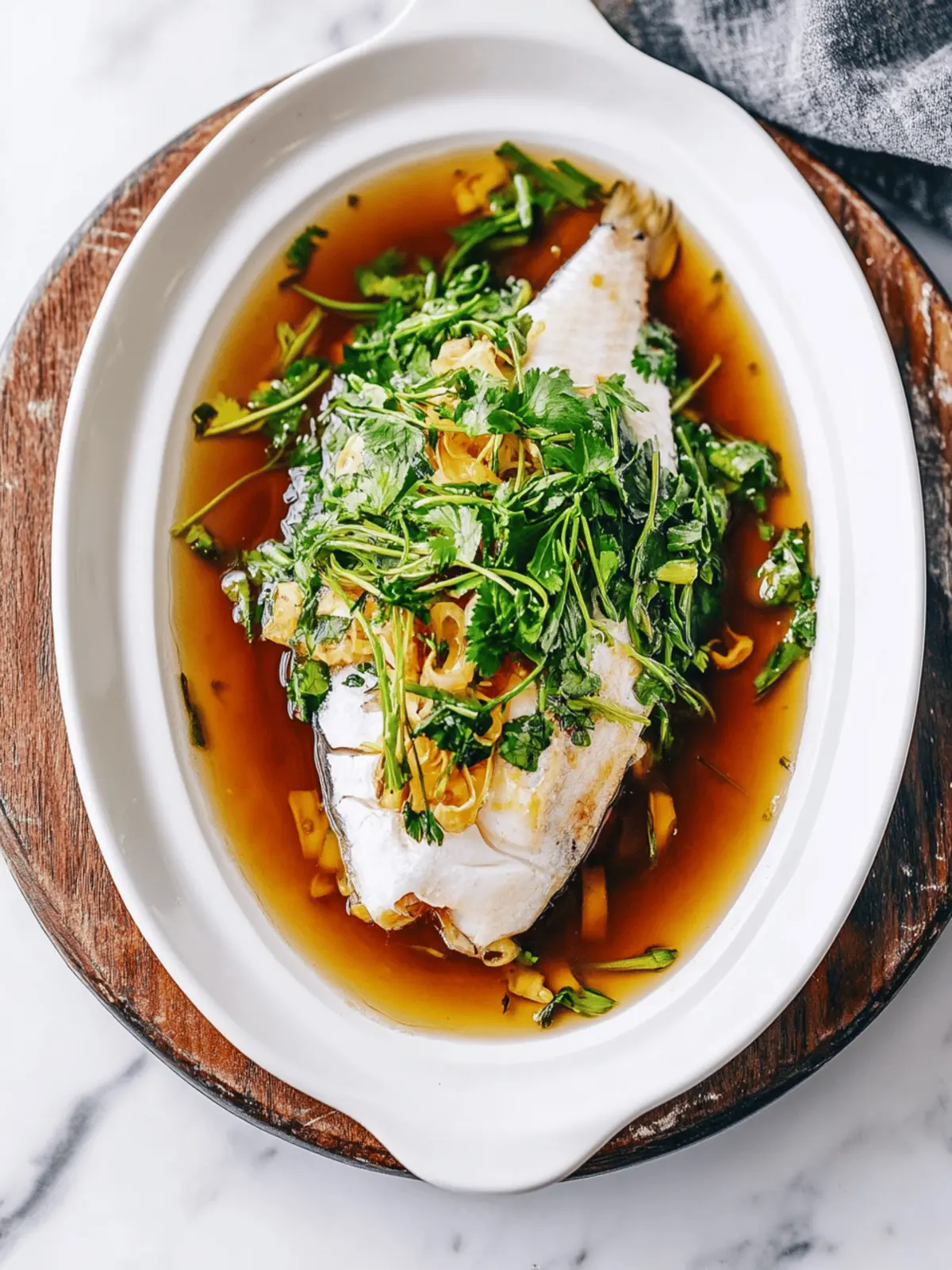There’s something truly special about the gentle steam rising from a freshly prepared dish, and that’s exactly what brings this Cantonese Steamed Fish to life. As the comforting aroma of ginger and scallions fills the kitchen, I can’t help but feel transported to a bustling Chinese restaurant, where this classic dish is served at celebrations and family gatherings alike. But why wait for a special occasion when this exquisite recipe takes just 20 minutes to make? Perfectly flaky fish adorned with a fragrant sauce transforms any weeknight dinner into something extraordinary.
With only a handful of fresh ingredients, this quick and easy recipe embodies the beauty of simplicity, offering an explosion of flavor that delights the senses. Whether you’re a busy chef or simply someone looking to elevate your homemade meals, Cantonese Steamed Fish is a versatile dish that is sure to impress. Get ready to bring a taste of authentic Chinese cuisine to your table without the hassle—let’s dive into this delightful recipe together!
Why Is Cantonese Steamed Fish So Special?
Quick preparation means you can delight in this flavorful dish without spending hours in the kitchen. Flavor-packed with ginger, scallions, and cilantro, each bite is a refreshing taste of tradition. Versatile enough to suit any palate, you can easily swap ingredients based on what you have on hand. Perfectly flaky and tender, the fish cooks in mere minutes, making it an ideal weeknight dinner. Plus, crowd-pleasing appeal ensures that everyone at your table will be asking for seconds!
Cantonese Steamed Fish Ingredients
For the Steamed Fish
• Fish Fillet (10 ounces) – Use delicate white fish like sea bass, flounder, or tilapia for optimal freshness and flavor.
• Salt – Enhances flavor; you can omit or reduce for low-sodium options.
For the Aromatics
• Scallions – Adds a fresh, aromatic punch; substitute with green onions if needed.
• Ginger – Provides a warm, spicy note; galangal works as a good alternative.
• Cilantro – Adds herbaceous freshness; consider parsley as a substitute for a different flavor profile.
For the Sauce
• Light Soy Sauce – Delivers umami and saltiness; tamari can be used for a gluten-free option.
• Sugar – Balances the sauce with subtle sweetness; honey or agave can serve as substitutes.
• Hot Water – Helps dissolve the sauce ingredients, ensuring a smooth consistency.
For Frying
• Vegetable Oil (2 tablespoons) – Perfect for frying aromatics; canola or olive oil are great alternatives.
This Cantonese Steamed Fish recipe is a quick, easy fish dish that’s sure to impress your family and friends!
How to Make Cantonese Steamed Fish
-
Prepare Aromatics: Start by cutting scallions into 2-inch lengths and julienning them. Thinly slice and julienne the ginger, then roughly chop the cilantro. Set these delightful aromatics aside to enhance your dish later.
-
Make Sauce: In a bowl, combine the light soy sauce, salt, sugar, and hot water. Whisk together until everything is nicely dissolved, and then set the mixture aside for that perfect drizzle later on.
-
Set Up Steamer: Fill your steaming setup—be it a wok or pot—with 1-2 inches of water. Bring it to a gentle boil, as this is crucial for the steaming process that gives the fish its tender texture.
-
Prepare Fish: Rinse the fish fillet under cold water. Place it on a heat-proof plate that fits comfortably in your steamer. Make sure it’s set and ready to go!
-
Steam Fish: Cover your steamer and let the fish steam for 7-10 minutes, depending on its thickness. Check for doneness with a butter knife; it should easily pierce the fish when it’s ready.
-
Drain and Garnish: Once cooked, turn off the heat and carefully drain any liquid from the plate. Garnish the fish with one-third of your prepared scallions, ginger, and cilantro for a fresh burst of flavor.
-
Make and Add Sauce: In a small pan, heat the vegetable oil. Add the remaining ginger and scallions to sauté briefly until fragrant. Pour in your soy sauce mixture, allowing it to bubble; then drizzle it over the fish for an irresistible finish.
-
Final Touch: Optional: For an extra flavor boost, heat a tablespoon of oil to pour over the raw aromatics before serving. This adds both flavor and a lovely presentation!
Exact quantities are listed in the recipe card below.
Cantonese Steamed Fish Variations
Customize your dish with these flavorful and delightful twists that will keep your taste buds dancing!
- Different Fish: Swap in salmon or halibut for a richer taste; just adjust the steaming time according to thickness.
- Spicy Kick: Add thinly sliced red chilies or a splash of sriracha to your soy sauce mix for a zesty burst.
- Herb Infusion: Experiment with fresh basil or mint instead of cilantro for a refreshing herbal twist on the dish.
- Citrus Zest: Incorporate a dash of lemon or lime juice in the sauce for a bright, tangy flavor that elevates the dish even further.
- Mushroom Variation: Toss in shiitake or enoki mushrooms to create a delightful umami balance; their texture adds another layer to enjoy.
- Steamed Veggies: Layer sliced bell peppers or bok choy on the plate with the fish before steaming for a wholesome meal in one.
- Nutty Finish: Drizzle a touch of sesame oil over the finished dish for a toasted, nutty flavor and a sophisticated aroma.
- Sweet Swap: Instead of sugar, try using a touch of coconut sugar or maple syrup for a natural sweetness with a hint of complexity.
What to Serve with Cantonese Steamed Fish?
Elevate your dining experience by pairing this light and fragrant dish with delightful accompaniments that will enhance every bite.
-
Steamed Jasmine Rice: The classic choice that absorbs the delicious sauces, bringing harmony to the meal’s flavors.
-
Stir-Fried Bok Choy: Crisp and vibrant, it’s a fresh vegetable option that adds crunch and nourishing greens to your plate.
-
Sesame Noodles: These flavorful, nutty noodles pair beautifully and offer a satisfying contrast in texture with their chewiness.
-
Cucumber Salad: A refreshing and zesty salad balances the rich flavors of the fish while adding a cool crunch to your meal.
-
Chili Garlic Sauce: For those who enjoy a kick, this adds a spicy depth that complements the gentle steam and freshness of the fish.
-
Hot Green Tea: A calming beverage that aids digestion and perfectly complements the subtle flavors of the Cantonese dish.
To create a memorable feast, consider this delicious kaleidoscope of flavors and textures as your savory canvas for the Cantonese Steamed Fish. Enjoy!
Make Ahead Options
Cantonese Steamed Fish is perfect for meal prep, allowing you to spend more time enjoying your meal rather than preparing it. You can prepare the aromatics—scallions, ginger, and cilantro—up to 24 hours in advance. Simply chop and store them in airtight containers in the refrigerator to keep them fresh. Additionally, you can make the soy sauce mixture a day ahead and refrigerate it. When you’re ready to serve, simply steam the fish and pour the heated sauce over it for a delightful finish. This way, you’ll enjoy all the flavors of this dish with minimal effort, ensuring the fish remains just as delicious!
Storage Tips for Cantonese Steamed Fish
Fridge: Store any leftover Cantonese steamed fish in an airtight container for up to 1 day to maintain its freshness and flavor.
Freezer: Although not ideal for this dish, if needed, you can freeze cooked fish for up to 2 months. Wrap it tightly in plastic wrap, then place it in a freezer bag to prevent freezer burn.
Reheating: Reheat the fish gently in the steamer for a few minutes until warmed through, ensuring it retains moisture and does not become dry. Avoid microwave reheating, as it may toughen the fish.
Serving: For the best taste experience, enjoy your steamed fish fresh. However, if storing is necessary, follow these tips to keep the dish as delightful as possible.
Expert Tips for Cantonese Steamed Fish
- Check for Freshness: Always choose fresh fish for the best flavor. A fresh fillet should have a clean smell and firm texture.
- Avoid Overcooking: Steam fish at a lower cooking time, starting with 7 minutes. Check doneness to prevent dry, overcooked fish.
- Use the Right Plate: Ensure your heat-proof plate fits comfortably in the steamer to allow steam circulation for even cooking.
- Garnish Wisely: Add aromatics after steaming for a vibrant look and fresh taste. They won’t lose their flavor or color this way!
- Experiment Freely: Don’t hesitate to try different fish or aromatic combinations based on seasonal availability and personal taste.
- Safety First: Be cautious when pouring hot oil over the aromatics; it can splatter, so control the heat to manage the splatter risk effectively.
Cantonese Steamed Fish Recipe FAQs
What type of fish is best for Cantonese steamed fish?
For Cantonese steamed fish, delicate white fish like sea bass, flounder, or tilapia work best due to their flaky texture and mild flavor. Always choose the freshest fillet available, ensuring it has a clean scent and firm texture, as this greatly enhances the final dish.
How should I store leftovers from Cantonese steamed fish?
Store any leftovers in an airtight container in the refrigerator, where they can last for up to 1 day. It’s best to enjoy the fish fresh, but if you need to store it, this will help maintain the flavor and texture. Reheat gently before serving to avoid drying it out.
Can I freeze my leftover Cantonese steamed fish?
Absolutely! You can freeze the cooked fish for up to 2 months. To do this, wrap the fish tightly in plastic wrap, then place it in a freezer bag to protect it from freezer burn. When you’re ready to enjoy it again, reheat it by placing it in a steamer for a few minutes until warmed through.
What do I do if my fish is overcooked?
If you accidentally overcook your fish, don’t worry! You can serve it with a drizzle of broth or a flavorful sauce to add moisture back into the dish. If your fish becomes tough, try shredding it for fish tacos or mixing it into a salad, where the flavors will shine through better.
Are there any dietary considerations for this recipe?
Yes, if you or anyone dining with you has allergies, be cautious with ingredients like soy sauce, which contains gluten. Substitute with tamari for a gluten-free option. Additionally, if you’re cooking for pets, remember that certain fish bones can be harmful, so ensure the fish is fully deboned before serving any to furry friends!

Cantonese Steamed Fish: Quick & Flavor-Packed in 20 Minutes
Ingredients
Equipment
Method
- Prepare Aromatics: Start by cutting scallions into 2-inch lengths and julienning them. Thinly slice and julien the ginger, then roughly chop the cilantro. Set these delightful aromatics aside.
- Make Sauce: In a bowl, combine the light soy sauce, salt, sugar, and hot water. Whisk together until everything is nicely dissolved, and then set the mixture aside.
- Set Up Steamer: Fill your steaming setup—be it a wok or pot—with 1-2 inches of water. Bring it to a gentle boil, as this is crucial for the steaming process that gives the fish its tender texture.
- Prepare Fish: Rinse the fish fillet under cold water. Place it on a heat-proof plate that fits comfortably in your steamer. Make sure it’s set and ready to go!
- Steam Fish: Cover your steamer and let the fish steam for 7-10 minutes, depending on its thickness. Check for doneness with a butter knife; it should easily pierce the fish when it's ready.
- Drain and Garnish: Once cooked, turn off the heat and carefully drain any liquid from the plate. Garnish the fish with one-third of your prepared scallions, ginger, and cilantro for a fresh burst of flavor.
- Make and Add Sauce: In a small pan, heat the vegetable oil. Add the remaining ginger and scallions to sauté briefly until fragrant. Pour in your soy sauce mixture, allowing it to bubble; then drizzle it over the fish for an irresistible finish.
- Final Touch: *Optional:* For an extra flavor boost, heat a tablespoon of oil to pour over the raw aromatics before serving. This adds both flavor and a lovely presentation!








